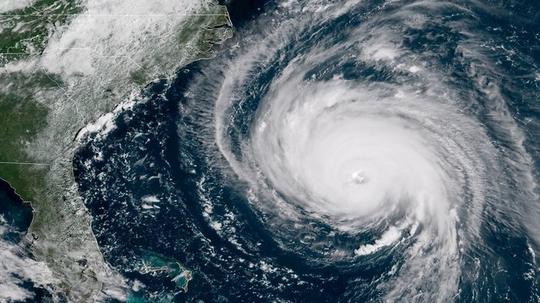
As Hurricane Florence barrels toward the Southeast coast of the United States, coastal towns in Georgia all the way up to Washington, D.C., are preparing for what's currently predicted to be "the most powerful storm to ever make landfall north of Florida."
The Category 4 hurricane, heralded as a "Mike Tyson punch to the Carolinas" by Jeff Byard, associate administrator for response and recovery at the Federal Emergency Management Agency, took a slight shift to the southwest Wednesday afternoon as its trajectory still suggests eventual landfall in the Carolinas.
In preparation for the dangerous storm, South Carolina, North Carolina, Virginia and Maryland declared states of emergency, and more than one million people are likely to evacuate.
But even Georgia stands in the wake of the monster storm; as of about 12 p.m. Wednesday, the Atlanta-Journal Constitution reported the latest projects point the storm more south, making parts of the Georgia coast in the path for heavy rain and potential flooding.
Channel 2 meteorologist Karen Minton warned the storm could curve back on the South Carolina Coast and head back to Georgia, or even down through the Savannah River valley and regaining traction as it heads north.
But how does tech come into play for massive storms like these? Just take a look at the last detrimental act of God that rocked our country: Hurricane Harvey.
Tech played a crucial role in the aftermath of Harvey. Houston software developers created Houston Harvey Rescue, a rescue system designed to take on the backlog of emergency calls when developers realized 911 could not handle in the influx. According to Venture Beat, the site led to more than 7,600 active rescues.
Drones have also come in handy in documenting damage sustained by hurricanes without putting boots on the grand. Atlanta's own startup Airbus Aerial aided during Hurricane Harvey and Irma by providing its library of aerial base maps and data analytics of affected regions to insurance companies.
Texas residents relied heavily on a free push-to-talk mobile app, Zello, that essentially works as a walkie-talkie to radio in supplies and areas where help was most needed. Waze, a free traffic and navigation app, was also utilized to redirect drivers out of areas hit by the storm. In 2016 during Hurricane Matthew, my brother and I used Waze to help navigate out of the Georgia coast and around evacuee traffic, closed roads, detours and even downed power lines.
Of course, social media always plays a huge role in tracking what's happening during the storm by those who choose not to evacuate and the immediate aftermath of the storm. Apps like Facebook, Twitter and Nextdoor were relied on heavily by Hilton Head Island residents when I was reporting on Hurricane Matthew for the Island Packet and the Beaufort Gazette. That also seems to be the case for Hurricane Harvey and Irma.
Take it from someone who's reported on the before, during and after of a hurricane: following local news organizations on social media is a crucial part of tracking the impact and predictions of the storm. While national news outlets have the major headlines, local coverage is more likely to give you information for your area, such as if gas and water are still readily available, which roads are closed, if grocery stores are still open, where to evacuate, locations for Red Cross shelters and if evacuation is mandatory.
Wireless providers such as Verizon, AT&T, Sprint and T-Mobile are sending in support crews and machinery to repair and restore connectivity following the storm, in addition to prepping drones to monitor tower damage sustained.
The Atlanta Business Chronicle reports Comcast has has opened up to 7,000 Xfinity WiFi hotspots in Savannah, Augusta and Charleston for connectivity, while the Atlanta Motor Speedway has opened its camping properties to evacuees. The publication also reports Atlanta shelters might also open to those seeking refuge from the story.
Even Switzerland-based Etherisc is trying to automate parts of insurance data collection in the aftermath of storms by moving the workflow to a shared, distributed ledger that would eventually allow automatic pay-out as a support to victims.
Some tech analysts have even posed that the incoming storm could be the biggest threat and test to the country's largest data center market.
Atlanta is typically a hub for storm refugees in the Southeast, branching all the way back to Hurricane Katrina. Expect an influx of people from the Carolinas and our own coast.
Even with powerful technology at use and aids during critical times like these, the best rule of thumb is to be prepared and stay informed.








